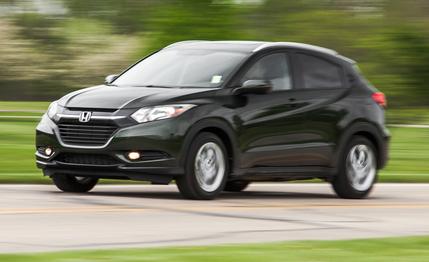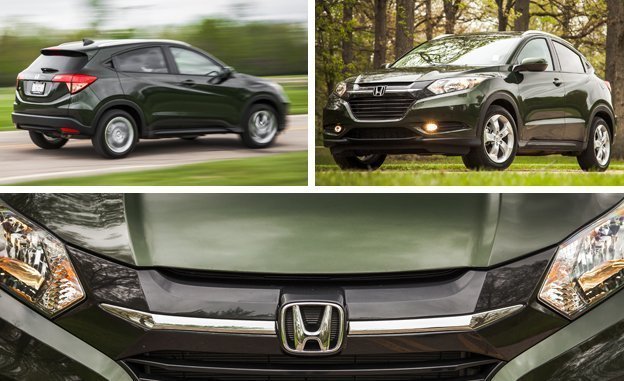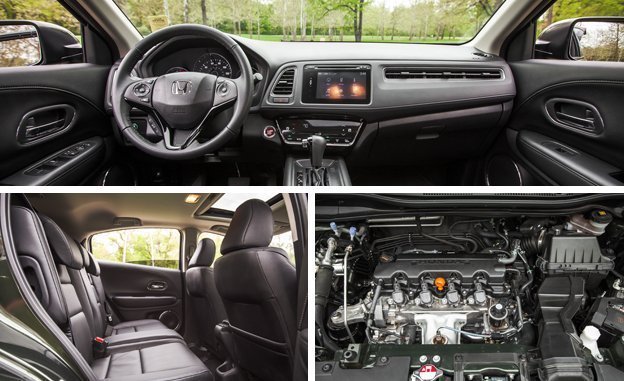 Instrumented Test
Instrumented Test
The appeal of the new tiny-crossover format lies in the intersection of a tall seating position, easy-to-park footprint, and all-wheel drive for year-round traction. Yet the explosive sales of the front-drive-only Kia Soul (more than 145,000 found homes last year) indicate that maybe the booster-seat effect and bite-size dimensions are more important than four driven wheels. All this is to say that the two-wheel-drive Honda HR-V reviewed here is a perfectly fine example of the emerging cute-ute breed.
People who find use for big parkas and who have a carpe diem attitude toward winter will buy the all-wheel-drive HR-V; quietly rebellious suburban types will snap up the (front-drive-only) stick-shift model; this automatic-equipped, front-drive HR-V is for everyone else. Among a rapidly ballooning populace that now includes the Buick Encore, Chevrolet Trax, Fiat 500X, Jeep Renegade, Nissan Juke, Mazda CX-3, and the Mini Cooper Countryman, the Honda espouses an inoffensive, widest-appeal philosophy, looking for all the world like an Acura RDX as viewed through beer goggles.

As our mothers remind us, however, it’s what is on the inside that counts. The HR-V’s gooey innards shine, and that’s mostly because they’re neither shiny nor gooey. Muted, soft-touch materials are everywhere, and on our top-spec $25,470 EX-L test car, leather lined the seats and stitched vinyl covered nearly the entirety of each door panel, the dashboard, and the center armrest. Lower trim levels get cloth-wrapped doors that are just fine, and if you can do without leather seats, navigation, and automatic climate control, the front-drive HR-V starts at $20,795 with a CVT. The design is clean and modern, although there aren’t any physical buttons or knobs to augment the touch-sensitive automatic-climate-control panel and the infotainment display. Overall, the ambiance is a marked step up over the somewhat cheap-seeming Fit subcompact on which the HR-V is based, with far less noise at highway speeds and a generally more substantial feeling.
Cleverness abounds throughout the HR-V’s design. Take, for example, the curvy-appearing roofline; it’s a visual trick hiding a nearly flat roof. Flipping and folding “Magic” rear seats borrowed from the Fit are reconfigurable in a gazillion different ways and when fully flattened open up 58.8 cubic feet of cargo space (slightly more than you get in the AWD HR-V). And despite the HR-V’s outward smallness, the rear seat serves up a limo-like 39.3 inches of legroom.

Honda wisely specified the larger Civic’s 1.8-liter four-cylinder engine—here with 141 horsepower—for the 3000-pound HR-V instead of the Fit’s 130-hp 1.5-liter four. Even so, the HR-V never feels particularly sprightly, although weighing 153 pounds less than the AWD version we tested recently, the front-driver is 0.9 second quicker to 60 mph and stops seven feet shorter from 70 mph. (The stick-shift HR-V is slightly zippier still.) The CVT is responsive enough in spinning up the engine for passing maneuvers but otherwise doggedly keeps the 1.8-liter four-cylinder engine’s revs low (low enough—think 1000 rpm—to make the entire car slightly vibrate). Nonetheless, the HR-V failed to exceed the window sticker’s combined fuel-economy rating, a feat every other HR-V we tested accomplished. We saw a so-so 26 mpg average, 2 mpg below the EPA city figure. The all-wheel-drive HR-V returned a whopping 35 mpg in our hands, while the stick-shift model managed 29 mpg overall.
The overall driving experience would be largely forgettable if not for the HR-V’s well-damped chassis, which provides a smooth highway ride. It might even be genuinely fun to drive were the steering ratio not so slow or the information stream from the front tires to the driver’s hands so sanitized. That’s the overall takeaway from the HR-V, really—it has some typical Honda intelligence mixed with a watered-down driving experience and sanitized styling. By taking such a middle-of-the-road route into the tiny-SUV fray, Honda assuredly will sell a ton of HR-Vs. But ultimately its extra dash of refinement isn’t really enough to justify passing over the less-expensive, equally useful, and more fun-to-drive Fit, much less several better small boxes like the Mazda CX-3 and the Kia Soul.